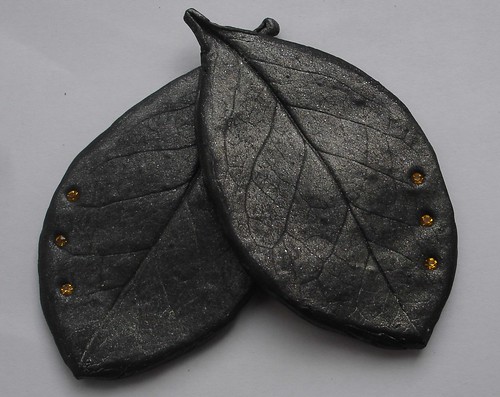As a polymer clayer, I whole heartily agree with her. Tools come in all shapes and sizes - from leaves and rocks to olive jars. Often enough, there's no need to part with money to achieve a beautiful clay piece.
Stamps
Molds and stamps are particularly expensive, and while they are sometimes irreplaceable, there are a number of every day objects and found items that can be used instead. The clay and crystal leaves below were stamped with leaves from the garden.

Using natural objects as molds or presses in your clay work can lend an organic feel to your pieces. The leaves above have subtle and soft details - something I might not have achieved with a manufactured stamp.
Below is another example of how clay artists can use readily available objects for texture and impressions. This pendant, made of black Fimo, was shaped and stamped with a natural stone. The porous surface of the stone created a beautiful and unique texture. The curvy impression was made with wire.

Other Tools
There's more to working with clay than the finishing touches. One of the most time consuming and exhausting parts of polymer clay is conditioning. For years I thought a pasta machine was vital to condition clay, and the price of one was off putting. Now, these and other tools have dropped in price and are not a huge investment for hobbyists.
There are still alternatives to things like pasta machines, like old fashioned elbow grease. Personally, I use a long glass jar, but you can easily use a sturdy roll of cling film. If you're a die-hard DIY fan, then you might consider buying your own acrylic tubing and having rolling pins in a variety of sizes.
Not Always about £
Unconventional tools allow for flexibility, subtlety, and can create beautiful clay art. They also allow you to practice before making larger investments into the hobby. Once you've found your niche in clay, you can always opt to pay for tools that make your work easier or faster. No matter how advanced we might become in the use of polymer clay, I think there will always be a place for the creativity and beauty that using natural and basic tools gives us.

1 comment:
Lovely blog entry, I love the black leafs very effective.
Post a Comment